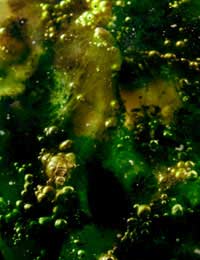Algae

Algae in the aquarium is a double edged sword. Sometimes it can be useful - as a food source for invertebrates and vegetarian fish - whilst at other times it can be a pollutant. Understanding how different kinds of algae function in the aquarium is essential to maintaining a healthy ecosystem and a beautiful looking tank.
Green algae doesn't cause water quality problems in the aquarium - in fact it works just like other plants, performing a helpful role in the nitrogen cycle. However, it can create problems for your plants by growing on their leaves so that they're unable to photosynthesise, sometimes causing them to die. It can also cause aesthetic problems, obscuring the aquarium glass.
Types of Algae
Contrary to popular belief, algae is not just one indistinguishable green mass. There are several different species which commonly grow within the aquarium.Algae as Food
Many vegetarian fish, and even some omnivores, enjoy eating algae, which can be highly nutritious and provide extra roughage in their diets. Some, like plecos, thrive on it, eating almost nothing else. If you don't have much algae growing naturally in your tank, you may need to supplement the diets of fish like these with commercially prepared spirulina algae discs.As well as providing a direct source of food, algae can help fish by sustaining the small crustaceans and zooplankton on which some of them live. A few fish, like damsel fish, actually cultivate small gardens of algae to provide them with food sources of this type.
Controlling Algae
The best way to limit the growth of algae in your tank is to present it with an inhospitable environment. This is difficult if you're using strong lights to aid plant growth and if you have a lot of fish producing waste which algae can use. The key is to keep your aquarium well planted, so that there are no left-over nitrates for algae to use, and to keep it well filtered, reducing the level of organic waste present in the water. You can buy commercial preparations for reducing the level of phosphate in the water. Reduce the use of plant fertiliser (if, indeed, you really need to use any) and try to feed your fish a bit less. Carry out regular water changes to improve your water quality.The best way to get rid of algae which has established itself is to employ suitable fish who will enjoy eating it. If this is not possible, or if your algae-eating fish are overwhelmed, try scraping it off surfaces with a razor blade or (in the case of acrylic tanks) with a piece of plastic. Don't clean such tools by just shaking them into the water - you need to get the algae right out of the aquarium, or it will re-attach itself.
Algae management in the aquarium can seem like a nightmare, but, once you've got your nitrogen cycle under control, it's really quite simple. Patient effort will be rewarded with crystal clear water and an aquarium which is a joy to look at.


Re: Providing Toys for Your Fish
Toys for my baby Flowerhorn fish??? And where to buy them ?
Re: Snail Infestations in Your Fish Tank
My coy fish just started darting and running into the glass. I've checked them over and see nothing on the outside of…
Re: My Pet Fish is 20 Years Old is this a Record?
I purchased a gold fish on April 1997 for my daughters and the same fish is alive and well. The reason I'm…
Re: Dealing with Bullying Between Fish
I have 3 Bolivian butterfly rams not sure the genders,but at the start all 3 were fine but just recently we’ve notice 2…
Re: Using Electrical Devices Safely In Your Aquarium
Monthly water changes isn’t enough I would be changing at least a 1/3 weekly. I do it more often than…
Re: Dealing with Bullying Between Fish
I have a blue gourami that has been living with 4 platty’s and a yoyo loach. I noticed a couple of my fish missing. I…
Re: Lighting for Aquatic Animals
Will a UV submersible light harm my tropical tank and fish. Thanks for any help
Re: Dealing with Bullying Between Fish
Recently put 12 new Africans in my 55 gallon tank. Many rocks and hiding places. After 2,3 days one of them, obliquidens,…
Re: Food Quantities
Just noticed smallest neon tetra tail is missing and white on the edges. Another also has half of tail missing. They was OK a few days ago. I only…
Re: Providing Toys for Your Fish
I have guppies and I think the ideas for toys might be too big, I have tried training them but they aren't responding.